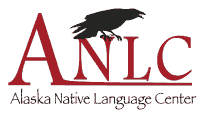Resources
-
Piciryaramta Elicungcallra: Yup'ik Immersion Language Education
Spring 2022Visit our new siteUAF's Applied Linguistics program and the Lower Kuskokwim and Lower Yukon School Districts have launched a new site, Piciryaramta Elicungcallra, about language immersion and programming.
-
Updated 10/8/18Read More
Read about Chief Peter John's 1994 blessing and vision for Troth Yeddha' and the University of Alaska Fairbanks.
-
Native Placenames of the Fairbanks Area
3/6/2012Although the modern city of Fairbanks was founded in 1901, the region in which Fairbanks is located has long been occupied by speakers of the (Lower) Tanana Athabascan language. The Native placenames of the region reveal a long history of use by Athabascan speakers. In fact, many common English names derive ultimately from Athabascan.Read article -
Inuit or Eskimo: Which name to use?
Although the name "Eskimo" was commonly used in Alaska to refer to Inuit and Yupik people of the world, this usage is now considered unacceptable by many or even most Alaska Natives, largely since it is a colonial name imposed by non-Indigenous people. Alaska Natives increasingly prefer to be known by the names they use in their own languages, such as Inupiaq or Yupik. "Inuit" is now the current term in Alaska and across the Arctic, and "Eskimo" is fading from use. The Inuit Circumpolar Council prefers the term "Inuit" but some other organizations use "Eskimo".Read article -
7/1/2011Athabascan is the name of the interrelated complex of languages indigenous to Interior Alaska, western Canada, the northern California and southern Oregon coast, and the desert Southwest United States.Read article
-
Inuit Snow Terms: How Many and What Does It Mean?
2003This paper was originally presented at the IPSSAS Seminar, 1 June 2003, and appears in the proceedings volume Building Capacity in Arctic Societies. Formatting may differ slightly from the original.Read More -
Mapping Alaska's Native Languages
The most widely accepted map of Alaska Native languages is Michael Krauss' Native Peoples and Languages of Alaska (1974, revised 1982).Read More -
The Dene-Yeniseian Hypothesis proposes a genetic relationship between the Na-Dene (or Athabascan-Eyak-Tlingit) languages of North America and the Yeniseian languages of Central Siberia.Read More
-
Alaska Native Language Websites
6/6/2012Programs concerned with Alaska Native Language RevitalizationRead More -
7/1/2011Four distinct Yupik (or Western Eskimo) languages are spoken along the shores of the Gulf of Alaska, in southwestern Alaska, and on the easternmost tip of Siberia. The Inuit (or Eastern Eskimo) language continuum is spoken in northern Alaska, Canada, and Greenland. Another Eskimo language, the virtually extinct Sirenikski of Siberia, is usually grouped with the Yupik languages although it may actually constitute a third distinct branch.Read More
-
Elders in western Alaska have compiled "A Guide to the Ethnobotany of the Yukon-Kuskokwim Region."Read More
-
The Institute on Collaborative Language Research (CoLang) was held on the campus of the University of Alaska Fairbanks in 2016. The institute was designed to provide an opportunity for community language activists and linguists to receive training in community-based language documentation and revitalization.Read More


